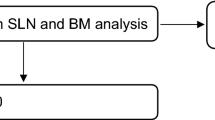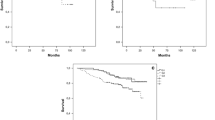Abstract
Bone marrow micrometastases (BMM) and sentinel lymph node (SLN) status are both prognostic factors in breast cancer (BRCa) patients (pts). A definitive relationship between the two has not yet been proven and the data available is controversial. Thus, a retrospective study was conducted to determine the relationship of BM status and SLN status in pts with early BRCa (T1/T2). All female pts with early BRCa (T1/T2) operated upon by a single surgeon were included in the study. Prior to surgery, all pts underwent bone marrow aspiration from the posterior superior iliac spine bilaterally. Subsequently, pts underwent SLN biopsy and definitive primary breast surgery. BM samples were examined by using a Cytokeratin Detection Kit using CAM 5.2 monoclonal antibody. All pts with BMM underwent repeat BM analysis 6 months after completing all treatments. Data was collected for SLN, BM, estrogen receptor/progesterone receptor (ER/PR), and human epidermal growth factor receptor 2 (Her-2/neu) status and analyzed using chi-square (χ 2) analysis or Fischer’s exact test. A total of 270 consecutive pts with early BRCa were studied. SLN mapping was successful in all pts. SLN metastases (mets) were detected in 28.9% (78/270) pts. Of the 270 pts, 77.0% (208/270) had T1 disease. BMM were detected in 9.6% (26/270) pts, of whom 69.2% (18/26) were found to have BMM unilaterally. BMM were detected in 11.5% (9/78) pts with SLN mets versus 8.9% (17/192) in pts with node-negative disease (p = 0.65). Of the pts with T1 BRCa, BMM were observed in 9.1% (19/208) pts versus 11.3% (7/62) in pts with T2 BRCa (p = 0.6). In pts with ER/PR-negative (−ve) BRCa, BMM were found in 7.7% (2/26) pts versus 9.9% (24/242) in pts with ER/PR-positive (+ve) BRCa (p = 0.27). BMM were detected in 12.3% (9/73) pts with Her-2/neu +ve BRCa and in 8.6% (16/187) pts with Her-2/neu −ve BRCa (p = 0.11). After completion of adjuvant therapy all pts with BMM (n = 26) converted to BM negative status. We conclude that BM status did not correlate with SLN status and occurs independently of lymphatic metastasis possibly through a different mechanism. BMM occur in node-negative pts and may assist in identifying pts at high risk for disease recurrence. Obtaining bone marrow aspirate from two locations resulted in a significant increase in detection of micrometastases.
Similar content being viewed by others
References
Jemal A, Murray T, Ward E, et al. Cancer statistics 2008. CA Cancer J Clin. 2008;58:71–96.
Conlin A, Seidman A. Use of the Oncotype DX 21-gene assay to guide adjuvant decision making in early-stage breast cancer. Mol Diagn Ther. 2007;11(6):355–60.
Glas AM, Floore A, Delahaye LJ, Witteveen AT, Pover RC, Bakx N, et al. Converting a breast cancer microarray signature into a high-throughput diagnostic test. BMC Genomics. 2006;7:278.
Mook S, Van’t Veer LJ, Rutgers EJ, Piccart-Gebhart MJ, Cardoso F. Individualization of therapy using Mammaprint: from development to the MINDACT Trial. Cancer Genomics Proteomics. 2007;4(3):147–55.
Rosen P, Groshen S, Saigo P, Kinne D, Hellman, S. A long-term follow-up study of survival in stage I (T1N0M0) and stage II (T1N1M0) breast carcinoma. J Clin Oncol. 1989;7:355–66.
Fisher B, Anderson S, Bryant J, et al. Twenty-year follow-up of a randomized trial comparing a total mastectomy, lumpectomy, and lumpectomy plus irradiation for the treatment of invasive breast cancer. N Engl J Med. 2002;347:1233–41.
Braun S, Floran D, Naume B, et al. A pooled analysis of bone marrow micrometastasis in breast cancer. N Engl J Med. 2005;353:793–802.
Braun S, Pantel K, Muller P, et al. Cytokeratin-positive cells in the bone marrow and survival of patients with stage I,II, or III breast cancer. N Engl J Med. 2000;342:525–33.
Langer I, Ulrich G, Gilles B, et al. Morbidity of sentinel lymph node biopsy alone versus sentinel lymph node biopsy and completion axillary lymph node dissection after breast cancer surgery. Ann Surg. 2007;245:452–61.
Trocciola S, Hoda S, Osborne M, et al. Do bone marrow micrometastases correlate with sentinel lymph node metastases in breast cancer patients? J Am Coll Surg. 2005;200:720–6.
Bonadonna G, Valagussa P, Moliterni A, et al. Adjuvant cyclophosphamide, methotrexate and fluorouracil in node-positive breast cancer: the results of 20 years follow-up. N Engl J Med. 1995;332:901–6.
Mansi J, Gogas H, Bliss J, Gazat J, Berger U, Coombes R. Outcome of primary breast cancer patients with micrometastases: a long term follow up study. Lancet. 1999;354:197–202.
Author information
Authors and Affiliations
Corresponding author
Rights and permissions
About this article
Cite this article
Saha, S., Ali, S., Ghanem, M. et al. Comparative Analysis of Bone Marrow Micrometastases with Sentinel Lymph Node Status in Early-Stage Breast Cancer. Ann Surg Oncol 16, 276–280 (2009). https://doi.org/10.1245/s10434-008-0244-0
Received:
Revised:
Accepted:
Published:
Issue Date:
DOI: https://doi.org/10.1245/s10434-008-0244-0




